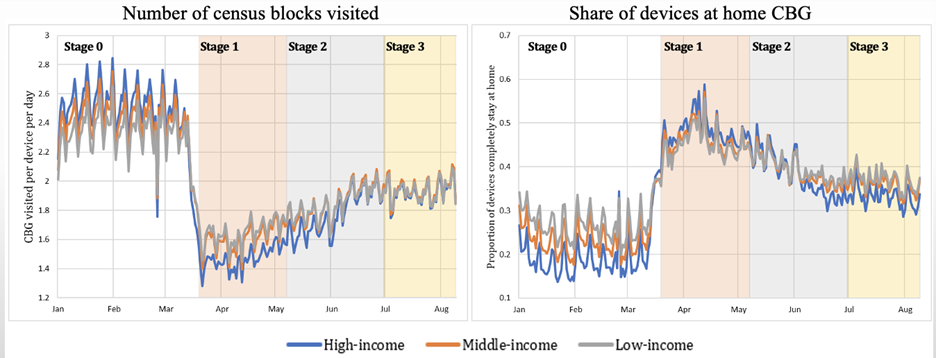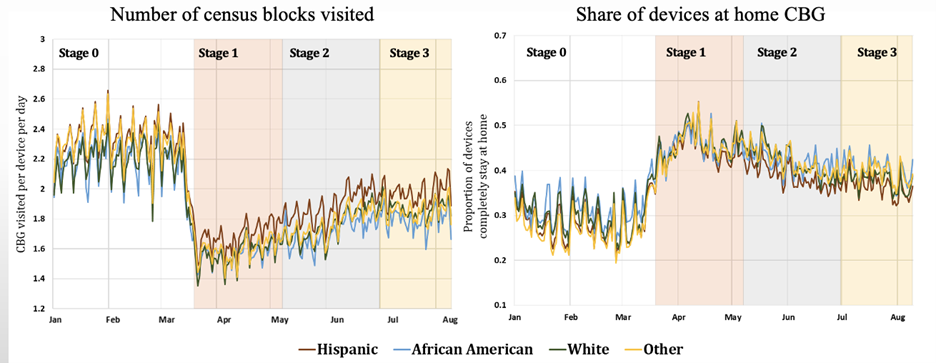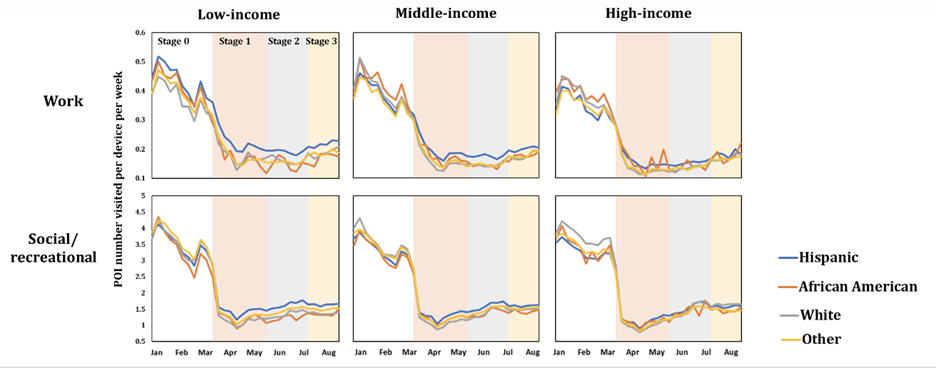News | METRANS Giuliano and Lu Research COVID Impacts on Mobility in Los Angeles
Stop the VideoNews

METRANS Giuliano and Lu Research COVID Impacts on Mobility in Los Angeles
Wednesday, April 28, 2021
by Hayley Rundle, USC Master of Urban Planning
On March 25th, METRANS and the Pacific Southwest University Transportation Center (PSR), along with special partner, the University of Southern California Associated Students of Planning and Development (USC ASPD), launched their third and final online research seminar for the Spring 2021 webinar series. USC ASPD is a student group representing Master of Urban Planning students that works to explore and promote academic and professional development issues related to the field of urban planning. ASPD and METRANS student team member Dan Lamere moderated the event on behalf of both of the organizations.
At this presentation, “Understanding Mobility Changes in Response to COVID-19: A Los Angeles Case Study,” Dr. Genevieve Giuliano and USC Doctoral Student Yougeng Lu showcased their ongoing research. Giuliano is a professor in the Sol Price School of Public Policy, USC, and director of the METRANS Transportation Consortium. Lu is a fourth-year Ph.D. candidate in Urban Planning and Development at the Sol Price School of Public Policy, USC, and a Research Assistant with METRANS.
The webinar attracted a large virtual audience, with attendance from transportation devotees across the nation, including public and private sector transportation professionals, faculty, researchers, and students at all levels of study. The session began with a formal presentation then moved to audience questions and comments.
Giuliano and Lu’s research is motivated by three research questions: How does COVID-19 affect people’s travel behavior? Do different population groups respond differently to COVID-19? Do different population groups respond differently to policy restrictions on mobility?
Lu began the presentation with a brief background of the COVID-19 pandemic, including the total number of cases and the types of non-pharmaceutical interventions that have been used throughout the pandemic. He shared that in Los Angeles County, the study area, more than 75% of COVID-19 cases were in the poorest neighborhoods, and 58.1% of COVID-19 cases were Hispanic/Latinx people. Disadvantaged populations are at a higher risk of contracting COVID-19 in Los Angeles County; only 12.2% of cases represent white individuals.
Lu explained that the study period of the research thus far runs from January 1, 2020, and to August 9, 2020. Within the study period, the researchers identified four different stages with differing policy interventions. Stage 0 is pre-pandemic, Stage 1 is the enforcement of the California statewide shelter-in-place order, Stage 2 is business re-opening, and Stage 3 is business restriction. On March 19, 2020, the beginning of Stage 1, California issued a statewide shelter-in-place order, which asked residents to stay home unless conducting essential activities, and closed non-essential businesses. On May 8, 2020, the beginning of Stage 2, LA County began its first phase of reopening non-essential businesses. Following the second resurgence of COVID-19 cases in California on July 1, 2020, the beginning of Stage 3, LA County closed many non-essential businesses once again to stop the spread.
Lu described how the mobility data was obtained for this research project. The data uses mobile phone data called from the company SafeGraph, which measures foot traffic patterns to various points of interest (POIs) based on GPS locations from mobile phone apps. The anonymous data was collected from 850,000 devices (~8.5% of the population) in LA County and aggregated at the Census Block Group (CBG) level. Demographic data was collected from the 2014-2018 American Community Survey (ACS), and internet and computer access data were collected from the USC Neighborhood Data for Social Change (NDSC). COVID-19 case data was collected from the Los Angeles Times. “This research showcases insightful analysis using a large sample of phone trace data [to] strengthen other analyses,” remarked Dr. Konstadinos Goulias, professor of transportation in the Geography Department at the University of California, Santa Barbara.

Figures demonstrate mobility changes during the COVID-19 pandemic.
To study how different groups respond to COVID-19, the researchers divided the Los Angeles population into different groups based upon income level and ethnicity. For income levels, population groups were identified as high-, middle-, or low-income based upon quartiles of median household income of each CBG. Ethnicity was determined based upon the proportion in each CBG identifying as White, Hispanic/Latinx, African American, and Other (e.g., Asian, Native American). This resulted in twelve different population groups. Then, a difference-in-difference regression model was used to evaluate the impact of various policies on mobility change among different population groups. Two mobility measurements were used to estimate the mobility change during the pandemic: CBG visited per device and proportion of devices that remain at home.
Lu then shared the research results; mobility response varies by income level and race/ethnicity, and mobility changes by trip purpose. Mobility changes across the four stages varied for each income level. As mentioned, the study includes three income groups: high-, middle, and low-income, and two mobility indicators: CBG visited per device and proportion of devices that remain at home to reflect the mobility level.
For the number of CBGs visited, there is a dramatic drop in mobility during the statewide shelter-in-place order (Stage 1). The decrease in mobility lasts until mid-April. After that, beginning in Stage 2, we observe a gradual rise in mobility. This trend levels off in early July when non-essential business closures were reinstated due to the second surge of COVID-19 during Stage 3. The results demonstrate that mobility also differs by income level. Before the pandemic in Stage 1, high-income groups traveled the most, and low-income groups traveled the least. In Stage 1, when the statewide shelter-in-place order was enforced, the pattern flips, with travel decreasing more for high-income groups, while low-income groups travel the most and stay at home the least. In Stage 2, differences amongst income groups tend to decline, with high-income group travel catching up with the low-income group amount of travel.

Figure showing how mobility response varies by income level.
The research demonstrated how mobility response also varies by race/ethnicity with a low-income example. Similar to the response by income, significant travel reduction occurred amongst low-income groups with the introduction of the statewide shelter-in-place order in mid-March. Among low-income groups, the research found that Hispanic/Latinx groups were the most likely to travel in comparison to White, African American, and other race low-income groups. Overall, the findings show that low-income and minority groups traveled more than high-income and White groups during the pandemic.

Figure showing how mobility response varies by race/ethnicity, low-income example.
Based upon these findings, the researchers were curious if the various mobility patterns of different population groups were consistent for all trips or different for different trip purposes, asking if low-income and minority groups travel more often for work trips or they are traveling more for shopping or recreational activities. To answer these questions, all trips were divided into five categories based on their trip purposes, including four discretionary trips: shopping, family/personal business, social/recreational, and medical/dental, and one non-discretionary trip: work trip. The researchers then estimated how to travel mobility changed for these trips during the pandemic.
The research revealed that low-income Hispanic/Latinx was the group that traveled the most throughout the pandemic across all trip purposes. When looking at the high-income groups, the results are mixed, showing a reduced gap between Hispanic/Latinx and the other three races for work and social/recreational trips. For the middle-income groups, Hispanic/Latinx groups travel the most for work with a smaller difference from the other three races when traveling for social/recreational purposes.

Figure showing how mobility changes based upon trip purpose.
Lu wrapped up the presentation with two main conclusions: the shelter-in-place order was most effective in reducing travel, and low-income and ethnic minority groups were more likely to leave home during the pandemic, both for work trips and discretionary trips. The reasoning behind this second conclusion could be because low-income and ethnic minority groups are less able to work from home due to a lack of access to the internet and digital resource, and most work at essential businesses or businesses that require in-person service.
We look forward to more research from Giuliano and Lu extending the time series to capture COVID-19 travel response after August 2020 to reflect the impact of the holidays and the winter surge in cases. The research team also hopes to consider the implications of reduced mobility on social interactions.
About the Author:
Hayley Rundle is a first-year Master of Urban Planning student at the USC Price School of Public Policy, concentrating in Mobility and Transportation Planning. Hayley is interested in sustainable transportation planning to improve environmental quality, equity, and mobility for all. Hayley serves as the team leader for the METRANS Industry Engagement and contributes to the Student Research Team, summarizing cutting-edge transportation research projects and findings for the METRANS Fast Facts for Students series.
News Archive
- December (1)
- November (6)
- October (4)
- September (2)
- August (3)
- July (4)
- June (3)
- May (7)
- April (8)
- March (11)
- February (8)
- January (7)
- December (7)
- November (8)
- October (11)
- September (11)
- August (4)
- July (10)
- June (9)
- May (2)
- April (12)
- March (8)
- February (7)
- January (11)
- December (11)
- November (5)
- October (16)
- September (7)
- August (5)
- July (13)
- June (5)
- May (5)
- April (7)
- March (5)
- February (3)
- January (4)
- December (4)
- November (5)
- October (5)
- September (4)
- August (4)
- July (6)
- June (8)
- May (4)
- April (6)
- March (6)
- February (7)
- January (7)
- December (8)
- November (8)
- October (8)
- September (15)
- August (5)
- July (6)
- June (7)
- May (5)
- April (8)
- March (7)
- February (10)
- January (12)















